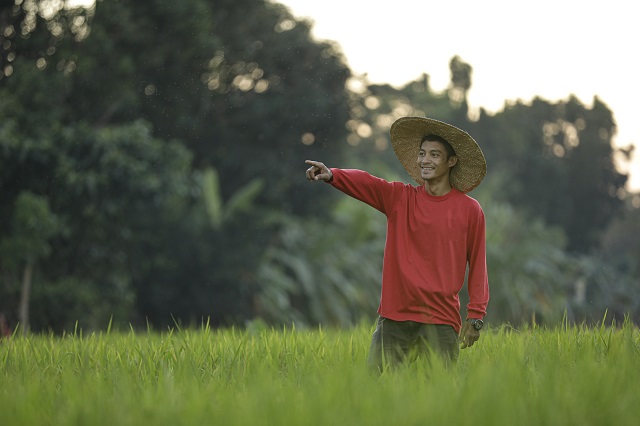
Rogel Comesario’s farm in Manaoag, Pangasinan was the center of attention on March 5, 2020 as the first Rice Competitiveness Enhancement (RCEF) produce was ceremonially harvested.
High-ranking national and regional government personalities graced the ceremony, engendering a virtual barrio-fiesta mood. The roaring combine harvester blended well with the output of the drum-and-lyre corps, and the loud speakers further intensified the noisy but pleasing rendition. It was musical democracy at its best.
It will be recalled that the first-ever RCEF seed distribution was done in late October 2019 in Pangasinan. The big province turned out to be the epicenter of the novel Seed Program, which, as of March 15, 2020, has distributed over 1.36 million bags of seeds to more than half million farmers nationwide. The appreciative Comesario, 38, tells us how he treated his RCEF seeds and how these helped him limit his production cost to the minimum.
NSIC Rc 222
The memories of the March 5 event were still vivid in the corners of Rogel’s mind.
“Everything happened so fast. Still, I was happy my farm was chosen as site of the ceremonial harvesting, and our barangay was proud of us,” he recollects.
A little more than 4 months ago, the college-educated farmer braved the long queue of seed distribution. Before this, he enlisted himself to the Registry System for Basic Sectors in Agriculture (RSBSA).
“The registration was a bit fast since not all barangays had to go on the same day during the distribution,” he appreciates the strategy.
When he reached the verification area, he uttered “Rc 222” – the variety of his choice and one of three nationally recommended varieties under the RCEF-Seed Program.
“I knew it yields high,” Rogel is certain.
His first seed distribution experience ended with him taking home two bags of high-quality seeds at 20kg each and a folded leaflet titled Gabay sa makabagong pagpapalayan.
“The leaflet had everything we needed from land preparation to harvesting. It served as our guide and I think it’s a big help for farmers who are new to rice production,” he says.
When it comes to sowing seeds, water is Rogel’s priority. It is a good thing that irrigation water is available for free in his area. He then transplanted the seedlings after 21 days following the recommendations he read from the leaflet. He admits that the way he managed his farm was based on the PalayCheck System.
As the Rc 222 seedlings grew on his 1-ha farm, he noticed that they were unlike other varieties, describing them as “pure” and “full”. The crop stand was also strong and sturdy and “not like the others that looked soft”.
“Walang halo!” he exclaims. Rogel also observed that they were slightly tolerant to rice bacterial blight.
Savings and profit
The free seeds helped Rogel save P1,500 – the cost that he used to pay for a 40kg bag of seeds, and P2,000 for the free irrigation.
“I always follow the recommended seeding rate and I noticed that it is more than enough because I would even collect excess seedlings after planting,” the father of three shares.
He says other farmers would even use three bags of seeds at 50kg each per hectare, thereby spending more than necessary.
With Rc 222, Rogel harvested 145 bags at 55-60kg each (fresh palay) or 7.9t/ha. Before, he used to harvest 5-6t/ha. He then sold it at P18.50/kg – a much better price than the P12-14/kg rate in 2019.
Second time’s a charm
After the ceremonial harvesting at his farm, Rogel once again lined up during the seed distribution for 2020 wet season planting and received two bags of Rc 222 anew.
He has yet to plant the seeds, but he vows to share what he has learned to his fellow farmers.
“As an agriculture graduate and a member of the agriculture committee in our barangay council, I want to convince my fellow farmers to follow the recommended seeding rate,” the Kagawad asserts.
He sees this advice as crucial in terms of lowering production cost while achieving higher yield.
The Pangasinan State University alumnus also suggests to program implementers to make the seed distribution in tune with the planting calendar of a certain area.
“Germination rate is important that is why it would be good if the farmer-beneficiaries would get the free seeds at the right time,” he recommends.
Frontliners
As he readies for the wet season crop, the country joins the whole world in battling a global pandemic called COVID-19. It has become more challenging for our farmers like Rogel to produce food.
“We are lucky to have been given the certificate allowing us to continue farm activities,” he says thankfully.
As a silver lining, calls for local government units (LGU) to buy palay directly from farmers have resonated.
“It is a good idea so long as the LGUs will buy our produce at a better price than the traders,” he rationalizes.
Despite the uncertain times, there is no reason to doubt our farmers’ resiliency. As the seed program moves to its second season of implementation, Rogel Comesario is hopeful that his first harvest from RCEF seeds won’t be his last.




